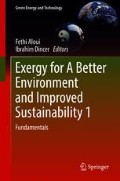Abstract
An experimental investigation is conducted to test the thermal behavior and characteristics of R134a clathrates with additives, as phase change materials (PCMs), for cooling applications, and their charging capabilities are analyzed and evaluated. The formation of refrigerant clathrates is investigated due to their potential use in active and in passive cooling applications such as in electronic and residential cooling. The PCMs are made using R134a clathrate and distilled water with different refrigerant proportions and five different additives. The main objective of using additives is to study their potential in enhancing the clathrate formation over a small temperature range under direct contact heat transfer. The PCMs are formed in glass tubes and their freezing onset and transformation time was recorded. The refrigerant R134a percentages of 25%, 30%, 35%, and 40% are used to form clathrate. For the additives, ethanol, sodium chloride, magnesium nitrate hexahydrate, copper, and aluminum were used. The PCMs are formed using controllable constant temperature water. The times for initial onset until the times, where the clathrate structure does not change (end-set), are recorded at regular intervals. The low charging time shows that the PCMs require low energy input to change its phase, whereas more time shows PCM takes more energy to do so. A comparative study is conducted to compare the charging time for different PCMs using the suggested additives. R134a refrigerant clathrate without any additive is used as the base case for comparison. The results show that metal additives reduce the freezing time (charging time), and ethanol and sodium chloride increase it, while magnesium nitrate hexahydrate maintains it the same as that of the base case of PCM. It is also found that the freezing time depends not only on the thermal properties of the used additives but also on their ability to mix homogenously in the refrigerant clathrate mixture. Furthermore, some additives are considered to be very useful in enhancing the clathrate formation with a stabilized crystalline structure. Finally, the PCMs with high latent heats over narrow temperature ranges are desirable as they offer high energy density at uniform reasonable temperatures applicable for cooling applications.
Access this chapter
Tax calculation will be finalised at checkout
Purchases are for personal use only
References
Bi, Y.H., Guo, T.W., Zhu, T.Y., Zhang, L., Chen, L.: Influences of additives on the gas hydrate cool storage process in a new gas hydrate cool storage system. Energy Convers. Manag. 47, 2974–2982 (2006)
Bi, Y.H., Guo, T.W., Zhu, T.Y., Fan, S.S., Liang, D.Q., Zhang, L.: Influence of volumetric-flow rate in the crystallizer on the gas-hydrate cool-storage process in a new gas-hydrate cool-storage system. Appl. Energy. 78, 111–112 (2004)
Dincer, I., Rosen, M.A.: Thermal Energy Storage – Systems and Applications. Wiley, Chichester (2002)
Duangthongsuk, W., Wongwises, S.: Measurement of temperature dependent thermal conductivity and viscosity of TiO2-water nanofluids. Exp. Thermal Fluid Sci. 33, 706–714 (2009)
Eastman, J.A., Choi, S.U.S., Li, S., Yu, W., Thompson, L.J.: Anomalously increased effective thermal conductivities of ethylene glycol-based nanofluids containing copper nanoparticles. Appl. Phys. Lett. 78, 718–720 (2001)
Eslamimanesh, A., Mohammadi, A.H., Richon, D.: Thermodynamic model for predicting phase equilibria of simple clathrate hydrates of refrigerants. Chem. Eng. Sci. 66, 5439–5445 (2011)
George, A.: Hand book of thermal design, Chapter 1. In: Guyer, C. (ed.) Phase Change Thermal Storage Materials. McGraw Hill Book Co. (1989)
Guo, K.H., Shu, B.F., Zhang, Y.: Transient behavior of energy charge– discharge and solid–liquid phase change in mixed gas-hydrate formation. In: Wang, B.X. (ed.) Heat Transfer Science and Technology, pp. 728–733. Higher Education Press, Beijing (1996)
Inaba, H.: New challenge in advanced thermal energy transportation using functionally thermal fluids. Int. J. Therm. Sci. 39, 991–1003 (2000)
Lia, J., Liangb, D., Guob, K., Wangc, R., Fanb, S.: Formation and dissociation of HFC134a gas hydrate in nano-copper suspension. Energy Convers. Manag. 47, 201–210 (2006)
Moghadassi, A.R., Hosseini, S.M., Henneke, D.E.: Effect of CuO nanoparticles in enhancing the thermal conductivities of monoethylene glycol and paraffin fluids. Indust. Eng. Chem. Res. 49, 1900–1904 (2010)
Mori, Y.H., Isobe, F.: A model for gas hydrate formation accompanying direct-contact evaporation of refrigerant drops in water. Int. Commun. Heat Mass Trans. 18, 599–608 (1991)
Murshed, S.M.S., Leong, K.C., Yang, C.: A combined model for the effective thermal conductivity of nanofluids. Appl. Therm. Eng. 29, 2477–2483 (2009)
Nikbahta, F., Izadpanada, A.A, Varaminianb, A.H.: Thermodynamic modeling of hydrate dissociation conditions for refrigerants R-134a, R-141b and R-152a. Int. J. Rerig. 35(7), 1914–1920 (2012)
Rosen, M.A., Dincer, I.: On exergy and environmental impact. Int. J. Energy Res. 21, 643–654 (1997)
Sloan, E.D.: Clathrate Hydrates of Natural Gases. Marcel, New York (1990)
Wua, J., Wangb, S.: Research on cool storage and release characteristics of R134a gas hydrate with additive. Energ. Buildings. 45, 99–105 (2012)
Author information
Authors and Affiliations
Corresponding author
Editor information
Editors and Affiliations
Rights and permissions
Copyright information
© 2018 Springer International Publishing AG, part of Springer Nature
About this chapter
Cite this chapter
Zafar, S., Dincer, I., Gadalla, M. (2018). Murshed Testing and Analysis of R134a Clathrates with Additives for Cooling Applications. In: Aloui, F., Dincer, I. (eds) Exergy for A Better Environment and Improved Sustainability 1. Green Energy and Technology. Springer, Cham. https://doi.org/10.1007/978-3-319-62572-0_39
Download citation
DOI: https://doi.org/10.1007/978-3-319-62572-0_39
Published:
Publisher Name: Springer, Cham
Print ISBN: 978-3-319-62571-3
Online ISBN: 978-3-319-62572-0
eBook Packages: EnergyEnergy (R0)

